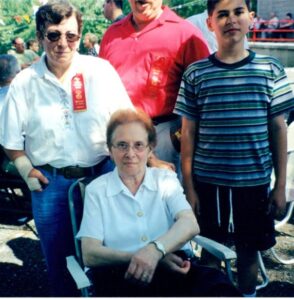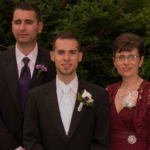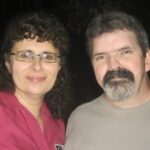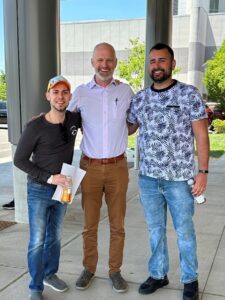ALS has had a profound impact on my family, and I write this with the aim of capturing our journey and ultimately raising funds to put an end to this disease.

It all began many years ago, when my grandmother was diagnosed with Lou Gehrig’s disease, as ALS was known at the time, at the age of 69. My brother, Chris, and I had little concept of what was happening to her, but the impact it had on our mom, Darlene, was easy to see. She was devastated, having to watch her own mom slowly waste away, passing away after about six months.
The disease lingered over the family, but eventually faded over time, as all things do, until a little over a decade later, when it came back to take more from us.
It started when my mom began to lose her voice. She seemed to have developed laryngitis recently, so we assumed it was a holdover from that, but her voice was raspy, and she was mispronouncing words. We didn’t know that it would never be the same again, and that she would soon lose her ability to speak entirely. She had also previously noticed pain in her hands, which became much more concerning once she started to experience weakness and lack of control.
It was clear that something was very wrong, so she began to be tested. She was tested thoroughly for multiple sclerosis, since many of the early symptoms are the same. Because ALS is diagnosed by elimination, people typically go through many months of various tests before knowing what is wrong. In our mom’s case, she started testing early in 2016 but wasn’t diagnosed until several months later, on Mother’s Day – at the age of 47.
 My brother recounts: “The day she found out she had ALS, she was frozen with fear. I took her in my arms, and we cried.”
My brother recounts: “The day she found out she had ALS, she was frozen with fear. I took her in my arms, and we cried.”
Things began to rapidly decline from there, as she lost her ability to swallow, walk, eat, or even use the bathroom. A feeding tube was needed to feed her, but no amount of liquid diet prevented her from wasting away. Her body would continually produce saliva, so someone would have to sit there and suction it every five minutes or she could choke.
It was throughout this time that ALS Canada’s support was crucial for the family. They helped with emotional support, and loaned equipment to help with the financial burden of the disease. They lent us a hospital bed, a commode, suction machine, wheelchair, power lift/recliner chair, and a bathtub grab bar. The ALS Canada Community Lead was wonderful and would come visit us every few weeks to check in, comfort us, and assist with the coordination of the equipment delivery. We are very grateful for ALS Canada’s support – donations that go towards research to find a cure, as well as assistance for families.
One of the many terrible aspects of ALS is being a prisoner in your own body. In many cases, the brain is largely unaffected, leaving you wanting to talk to your loved ones, or embrace them, but being unable to. For months, friends and family would visit but would struggle to understand even the most basic things she was trying to get across to us. A daily struggle for my brother and her lifelong friend, Joe, since they were always by her side. Mutual frustration, on top of the depressing nature of the situation. Six months later, just a couple of weeks after her 48th birthday, she passed away peacefully in the night.
 Her death was devastating for all of us, but Joe took it particularly hard. They were inseparable. He was always there for her – as her go-to person, her lifelong friend, and ultimately a substitute father to Chris and I. Life wasn’t easy as a single mom, but she did everything she could to prioritize us and Joe would step in where necessary, to help her along all these years. Joe’s struggle after her death ultimately cost him his own life three years later.
Her death was devastating for all of us, but Joe took it particularly hard. They were inseparable. He was always there for her – as her go-to person, her lifelong friend, and ultimately a substitute father to Chris and I. Life wasn’t easy as a single mom, but she did everything she could to prioritize us and Joe would step in where necessary, to help her along all these years. Joe’s struggle after her death ultimately cost him his own life three years later.
After our mom’s passing, Chris and I set out to do whatever we could to fight this disease. While she was still alive, and to this day, we take part in the ALS Canada Walk to End ALS. Chris also hosted an event that raised over $5,000 for ALS Canada. But we also wanted answers, and to help with research.

It was already suspected that a genetic variant ran in the family that was dramatically increasing our likelihood of developing ALS, but it wasn’t any of the already well-known variants. It wasn’t until years later, as we sought out our own genetic testing, that variants in the KIF5A gene, the mutation that runs in our family, were officially linked to ALS (or deemed pathogenic, as the white coats like to say).
I wanted to know if I carried the mutation and to provide DNA samples that could be used in research, so I sought out a genetic counsellor. It turned out to be much more difficult than we expected. It took about a year before we were finally tested through a lab at McMaster University.
Chris was hesitant to find out at first, but eventually came around to the idea. So, we both had a great visit, provided our blood samples, and waited. Several weeks later, we received the news – Chris did not carry the gene mutation, but I did.
So there it was, an answer to what had been floating around in my mind for years. Thankfully, my pragmatic approach was to always assume I carried the mutation and try to minimize onset, if at all possible. So, it wasn’t a shock for me to find out – but it sure would have been a happy surprise if I hadn’t carried it.
As all of this was happening, my cousin Kyle started to develop symptoms at the painfully young age of only 24. It started with one of his legs being weak and was progressing slowly, so we held out hope that it was anything other than ALS. It was about two years later that all other options were exhausted, and it was clear that he had ALS. As is common with younger-onset ALS, Kyle’s progression has been slow. He has remained positive throughout his struggle, serving as an inspiration to others.
 Apart from raising money, it has always been important to me to assist research efforts. This goal brought my brother and I to visit The Ohio State University to meet with Dr. Kolb, where I provided blood samples and a skin biopsy. This will allow the lab to grow tissues from my sample to study KIF5A gene variants. It was great to visit a lab that was performing active research on KIF5A, specifically.
Apart from raising money, it has always been important to me to assist research efforts. This goal brought my brother and I to visit The Ohio State University to meet with Dr. Kolb, where I provided blood samples and a skin biopsy. This will allow the lab to grow tissues from my sample to study KIF5A gene variants. It was great to visit a lab that was performing active research on KIF5A, specifically.
Since then, I’ve visited Columbia University in New York to meet with Dr. Neil Schneider and provide blood samples and another skin biopsy, as part of the Silence ALS project. Kyle also provided samples.
Other than continuing to raise money and contribute to research, I hope that the ALS story for our family is over. But my brother and I continue to fight to end the ALS story for everyone.
The deepest of thanks to everyone who has donated over the years. It goes a long way towards honouring the memory of our mom. ❤️
“In My Words” is an ALS Canada story series illustrating life impacted by ALS through first-person storytelling. Whether that’s through the written word, audio, art, music, etc., community members will share their experience in their own way.
You can make a difference.
Donations provide crucial services and information to people living with ALS and allow us to invest in research and advocacy dedicated to improving quality of life.
